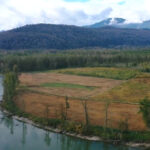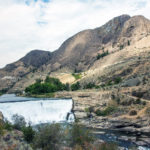“The restoration of Britannia Creek highlights the fact that we should never give up on any river.” ~Mark Angelo
Britannia Creek flows into Howe Sound approximately 55 kilometers north of Vancouver, British Columbia, Canada. A major copper discovery in the upper part of the Britannia Creek watershed in 1888 led to the development of the Britannia Mine. The mine went into full production in 1905 and boomed in the late 1920s, becoming the largest producer of copper in the British Commonwealth by 1929.
While the mine generated major economic benefits for both the local community and Province, it came at a huge environmental cost. While the mine finally closed in 1974, snow-melt and rainwater continued to flow through the mine’s abandoned tunnels. When combined with oxygen and the high sulphide content of the mine’s waste rock, a condition known as acid rock drainage (ARD) was created. ARD is caused by a chemical reaction which results in highly acidic, toxic runoff that contains large concentrations of dissolved metals such as copper, iron, cadmium, and zinc.
As a result of ARD, which continued even after the mine’s closure, Britannia Creek had become severely polluted. For close to a century prior to December, 2001, polluted run-off was being deposited directly into Howe Sound by means of Jane Creek and Britannia Creek and as much as 450 kilograms (close to 1000 pounds) of copper was entering Howe Sound daily. To many casual observers, Britannia Creek’s clear and transparent water suggested a pristine environment; however the clarity of the water was, in fact, an indication that no living creatures, from fish to insects, could survive in it.
Pollution was not just confined to the creek. Howe Sound, into which the creek drains, was also being severely impacted. A strip of several kilometers of marine habitat straddling the community of Britannia Beach was seriously polluted, affecting million of juvenile chum salmon from the nearby Squamish Estuary. A federal fisheries report revealed that spring salmon held in cages off Britannia Creek died in less than 48 hours because of the toxic metals in the water, whereas fish held off Porteau Cove to the south had a 100 per cent survival rate.
Both the creek and part of Howe Sound near Britannia Beach had become one of Canada’s most notorious toxic hot-spots. Concerns about the state of both Britannia Creek and Howe Sound were frequently expressed throughout the 1980’s and 90’s by Mark Angelo (then Program Head of BCIT’s Fish, Wildlife and Recreation department) and others, who helped to increase public awareness about the seriousness of the issue.
Through an extensive media campaign, Angelo profiled the state of the creek which was completely lifeless; devoid of fish and aquatic insects. He documented the extent of the dead zone that had developed in Howe Sound near the creek’s outlet. Angelo was an early advocate of the need for a multi-pronged approach to rectifying the pollution problem. While part of this called for diverting polluted runoff from the creek, another key element that would entail the building of a treatment plant to neutralize the acidic runoff entering into How Sound, something he felt historically responsible parties behind the pollution should help fund.
In 2001, Britannia Creek was designated by the Outdoor Recreation Council as BC’s most endangered river. The area was also designated as the “worst point source of mineral contamination in North America” by the federal Environment Ministry.
Growing public concern finally helped to spark tangible efforts to rectify the problem. In the summer of 2001, the Province of British Columbia formally announced that a large scale treatment would be built to neutralize the run-off coming off the old mine site. As Angelo and other river advocates had hoped, a portion (i.e. 30 million dollars) of the capital funds did come from past operators of the mine site, while the remainder, including annual operating costs, came from the Province. While the treatment plant did not become fully operational until 2006, its construction marked a pivotal turning point for Howe Sound and the community of Britannia Beach. The plant, now operated by EPCOR, treats an average of 4.2 billion liters of run-off annually, removing an average of 226,000 kilograms of heavy metal contaminants.
On another front, Engineers from the Centre for Environmental Research in Minerals, Metals, and Materials at the University of British Columbia installed a concrete plug in the 2,200-foot level mine entrance (known as an adit) in December 2001 as the initial step in constructing a more substantial Millennium Plug. The idea for the installation was to create a laboratory to study ways to seal mine adits using bulk materials. At the same time the installation would immediately stop all pollution from the 2200 Level into Jane Creek, a tributary of Britannia Creek. UBC researchers invited the Provincial government to participate in the project. The Province was willing to participate to the extent of providing funding for the minimum plug work required to address its needs. From the perspective of the UBC researchers this was not adequate. The UBC researchers then chose to work with the owners of the site at the time, sharing equally in the cost of the project.
The plug effectively diverted acid mine drainage away from the creek and into a deep outfall pipe into Howe Sound. This resulted in less impact to the creek, but the run-off continued to substantially affect the aquatic ecosystem of Howe Sound and the creek’s estuary. Field monitoring done in 2003, using intertidal algae and mussels as ecological indicators, showed that the recovery of coastal biological communities was actually minimal. However, recovery of Britannia Creek was significant and the amount of copper and zinc in the total discharge waters declined by about 20%.
Following completion of the Water Treatment Plant in 2006, it was estimated that 90% of the pollution to Howe Sound had been stopped. Optimization of the groundwater management system by 2008, further increased the reduction to 99%.
In recent years, there has been a marked improvement in the conditions of the creek and its estuary. In 2011, pink salmon returned to Britannia Creek for the first time in over a century, sparking much jubilation. Much of Howe Sound also sprung back to life in the years following completion of the treatment plant and species ranging from Killer Whales to White Sided dolphins are now regularly seen near the creek’s outlet. Shell fish have also re-colonized much of the nearby sea bed.
Among other positive developments, in 2015, the Provincial government turned its attention to the potential to decommission the 7 dams that exist in the upper parts of the Britannia Creek watershed and which use to be part of the mine site’s electricity generating infrastructure. These dams, close to a century old, have outlived their usefulness and are in a dilapidated state and beyond repair. Their removal has public safety benefits but the dismantling of some of these old structures will also have environmental spin-offs in terms of improving resident fish passage and habitat connectivity. The idea of removing some of these structures over time , especially the Tunnel Dam, was first broached in 2001 in a report overseen by Mark Angelo and the Outdoor Recreation Council and written by Rod and Laurie Stott entitled River Recovery.
The restoration of Britannia Creek and part of Howe Sound, once so polluted, is widely considered to be a remarkable achievement.







